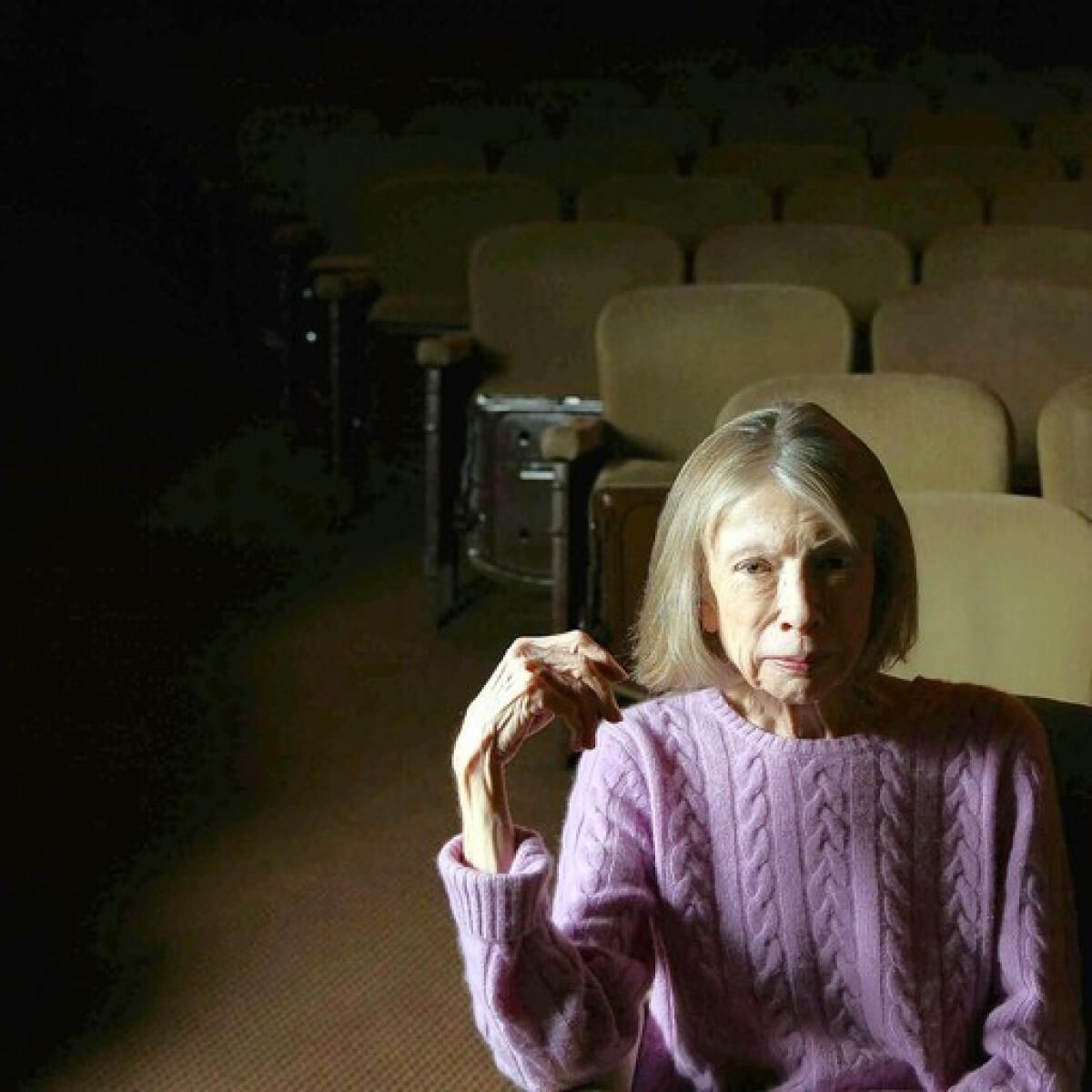Joan Didion’s new collection of old essays holds the key to her ‘shimmer’

- Share via
On the Shelf
Let Me Tell You What I Mean
By Joan Didion
Knopf: 192 pages, $23
If you buy books linked on our site, The Times may earn a commission from Bookshop.org, whose fees support independent bookstores.
“You know, sometimes I think I can’t think at all unless I’m behind my typewriter,” Joan Didion told an editor for Ms. magazine during an interview at the author’s Malibu home. It was January 1977, and Didion’s third novel, “A Book of Common Prayer,” would be published in March. The editor, Susan Braudy, had asked Didion to describe a scene from her life so quintessential that it could open a nonfiction piece about her.
After demurring several times, Didion finally told Braudy about a moment during one of the many parties she and her husband, John Gregory Dunne, hosted at their Trancas beach house, when she began to feel “scattered, upset, not myself.” Instead of going for a walk along the shore or taking a break in the bathroom, she went to her office and sat at her typewriter. “And it was okay. I got control,” she said. “I’m only myself in front of my typewriter.”
In “Why I Write,” a piece in Didion’s new nonfiction collection, “Let Me Tell You What I Mean,” she famously declares that she writes “entirely to find out what I’m thinking, what I’m looking at, what I see and what it means.” But “Why I Write” — first presented as a lecture at the University of California, Berkeley, then adapted for the New York Times Book Review in December 1976 — constitutes a deeper drive than the parsing and ordering of observations; Didion’s why subsumes an existential inquiry into the compulsion to write anything at all, questioning the source of inspiration and asking who, or what, is ultimately in control.
In the essay, Didion describes a particular “shimmer” that would form around images in her mind, creating a frame of sorts that pulled her in, impelled her to set down words as a means of telling the scene into being. She compares this shimmer to the way a schizophrenic or someone under the influence of psychedelic drugs is purported to perceive his surroundings — ”molecular structure breaking down,” foreground and background “interacting, exchanging ions.”
“I’m not a schizophrenic, nor do I take hallucinogens,” she continues, “but certain images do shimmer for me. Look hard enough, and you can’t miss [it].” Didion goes on to illustrate several tableaux that emitted the shimmer: the minor actress with long hair and a short halter dress, walking alone through a Las Vegas casino at 1 a.m., who inspired the dissolute ennui of her 1970 Hollywood novel, “Play It As It Lays”; and an early morning at the Panama airport, heat rising off the tarmac, into which the author inserted Charlotte Douglas, one of the main characters in “A Book of Common Prayer,” with her square-cut emerald ring and a demand for tea made from water boiled for 20 minutes (no doubt drawing on Didion’s own bout with dysentery after visiting said airport).
Christine Lennon, Su Wu and others contribute essays to a collection on the master essayist
“I knew why Charlotte went to the airport even if Victor did not,” Didion wrote in the novel — although, as she reveals in this essay, “until I wrote these lines I had no character called Victor in mind. ... Most important of all, I did not know who ‘I’ was, who was telling this story.’”
More than a decade later, the shimmer still held sway over Didion, even if she no longer used the term. In the 1989 essay “Some Women,” an introduction to a Robert Mapplethorpe monograph that is included in the new collection, she writes of the superstition some artists maintain around their practices. Mapplethorpe muses on a “magic of the moment,” professing, “You don’t know why it’s happening but it’s happening.” For her part, Didion reveals, “I once knew I ‘had’ a novel when it presented itself to me as an oil slick, with an iridescent surface. … I mentioned the oil slick to no one, afraid the talismanic hold the image had on me would fade, go flat, go away, like a dream told at breakfast.”
However arbitrary and unrelated a tarmac at dawn and an actress in Vegas might seem to be, each image is pregnant with potential: the airport pointing to travel and adventure and possibly danger, the actress getting closer to — or maybe further from — stardom and wealth. The “talismanic hold” they had on Didion have everything to do with these tensions.

Hilton Als, the New Yorker critic and avowed Didion fan, mentions the shimmer in his foreword to “Let Me Tell You What I Mean.” By his analysis it is a “physics or energy” related to Sigmund Freud’s concept of the uncanny — “synonymous with and expressive of ‘all that arouses dread and creeping horror.’”
I disagree. Didion’s concept of the Golden Dream — the infinite promise of California as introduced in the first essay of her first collection, “Slouching Towards Bethlehem” — is often viewed through a dark lens. But as I interpret both the Golden Dream and the shimmer, their power lies in what is possible, not in what becomes of that possibility — which in the case of that opening essay, “Some Dreamers of the Golden Dream,” was a grisly murder and an incarceration. Similarly, I would categorize the shimmer not as a physics but a metaphysics — a portal to a liminal space where human potential and the transformational power of language are put to the test.
Library of America collection tracks Joan Didion’s emergence through her 1960s and ’70s works.
Reading “Let Me Tell You What I Mean” with an eye toward the shimmer, I believe it is possible to identify which pictures, crystalline and resonant, drew Didion closer and compelled her to string words together until the molecules manifested a new truth.
In “Getting Serenity,” one of six late 1960s essays originally published in the Saturday Evening Post, I imagine it’s the white cake served at a Gambler’s Anonymous meeting in Gardena, with a pink icing inscription reading “Miracles Still Happen.” In “A Trip to Xanadu,” it can only be the Moorish towers of William Randolph Hearst’s mansion in San Simeon, “floating fantastically above the coastal fog,” which Didion recalls being told to watch for as a child during family drives along Highway 1. To this descendant of California pioneers, “San Simeon seemed to confirm the boundless promise of the place we lived. ... If a Hearst could build himself a castle, then every man could be a king.”
For all the insights in “How I Write,” perhaps as much can be gleaned from the moments in the lecture omitted from the printed version. Addressing the Berkeley audience, Didion spoke of the vicissitudes of life as a professional writer. “I do make a living writing,” she acknowledged, as quoted by Ms. editor Braudy, who was present, “but I have never been convinced by anyone that there are not easier ways to make it. I think of alchemy as one.”
Of course, she meant this sarcastically, implying that it was easier to turn a hunk of lead into gold than to commit indelible truths to paper. But isn’t the transmutation of dull, dense matter into something shining and precious a perfect metaphor for the writing process, and one that also happens to apply to the promise of California? The shimmer lets you know you’re getting closer to the gold.
Taschen’s “The Library of Esoterica,” a series that begins with “Tarot” and “Astrology,” honors the history of mysticism and its democratization.
Nelson is the editor of “Slouching Towards Los Angeles: Living and Writing by Joan Didion’s Light” and the co-author of “Judson: Innovation in Stained Glass.”
More to Read
Sign up for our Book Club newsletter
Get the latest news, events and more from the Los Angeles Times Book Club, and help us get L.A. reading and talking.
You may occasionally receive promotional content from the Los Angeles Times.








